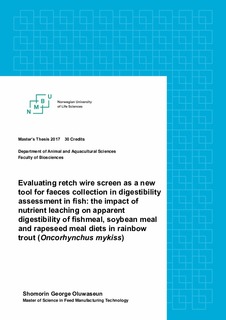| dc.contributor.advisor | Hansen, Jon Øvrum | |
| dc.contributor.advisor | Storebakken, Trond | |
| dc.contributor.advisor | Øverland, Margareth | |
| dc.contributor.author | Shomorin, Oluwaseun George | |
| dc.date.accessioned | 2017-09-08T09:02:56Z | |
| dc.date.available | 2017-09-08T09:02:56Z | |
| dc.date.issued | 2017 | |
| dc.identifier.uri | http://hdl.handle.net/11250/2453710 | |
| dc.description.abstract | The study was carried out to evaluate the retch wire screen as a potential tool for collecting feces from water, by comparing its apparent digestibility estimates with that of the conventional stripping method. The retch wire screen is designed as a wire mesh for collecting or trapping feces that is removed from the tank along with the outlet water. The slots between the wire screens allow the passage of the outlet water while the trapped feces are collected from the wire screens for analysis. Three different diets with fishmeal, soybean meal and rapeseed meal were produced by extrusion. The diets were fed once a day to triplicate groups of rainbow trout with an average weight of 120 grams, reared in 14oC freshwater. The experiment lasted for 22 days. Feces were obtained by careful stripping from the distal abdomen and collected from the wire screen 15, 30, 60, 120 and 240 minutes past feeding. Faecal dry matter, organic matter, carbon, nitrogen, sulphur and yttrium oxide (Y2O3) were analysed in diets and freeze dried feces samples, and apparent digestibilities (AD) were calculated.
AD estimates of organic matter, nitrogen and sulphur obtained by collecting feces on the wire mesh collector were higher than AD estimates obtained by the stripping method, except for some values obtained for AD of carbon. This shows that leaching of nutrients from the feces was immediate. Compared to this initial leaching of nutrients, the leaching loss caused by prolonged collection times from 15 to 240 minutes was small. The percentage difference observed in AD estimate between stripping and feces collected with the retch wire screen were lower than values reported in previous methods of feces collection from water media.
The relative ranking of the apparent digestibility among the 3 diets in the ANOVA analysis showed the same statistical ranking, and this may facilitate use of the tool, eventually by the employment of a correction factor.
There were significant differences observed in the faecal dry matter among the diets for both methods of faecal collection. Soybean meal showed the lowest faecal dry matter among the diets. AD of nitrogen was significantly higher for the soybean meal diet than for the fishmeal diet when feces were obtained by stripping. Soybean meal also gave the highest estimates of nitrogen AD for feces collection at all the time intervals while rapeseed meal recorded the lowest Nitrogen AD. Rapeseed meal also showed the poorest digestibility in both methods of faecal collection for organic matter, carbon and sulphur. Sulphur AD obtained with the rapeseed meal diet by the stripping method was particularly low (54.7%), compared to the fishmeal and soybean meal diets that had 72.4 and 70.1% respectively. The likely reason for this was attributed to low digestibility of sulphur containing amino acids in the rapeseed, possibly due to antinutrient factors. | nb_NO |
| dc.language.iso | eng | nb_NO |
| dc.publisher | Norwegian University of Life Sciences, Ås | nb_NO |
| dc.rights | Navngivelse 4.0 Internasjonal | * |
| dc.rights | Attribution-NonCommercial-NoDerivatives 4.0 Internasjonal | * |
| dc.rights.uri | http://creativecommons.org/licenses/by-nc-nd/4.0/deed.no | * |
| dc.title | Evaluating retch wire screen as a new tool for feces collection in digestibility assessment in fish: the impact of nutrient leaching on apparent digestibility of fishmeal, soybean meal and rapeseed meal diets in rainbow trout (Oncorhynchus mykiss) | nb_NO |
| dc.type | Master thesis | nb_NO |
| dc.subject.nsi | VDP::Agriculture and fishery disciplines: 900 | nb_NO |
| dc.source.pagenumber | 48 | nb_NO |
| dc.description.localcode | M-FT | nb_NO |

